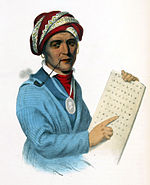Portal:Indigenous peoples of the Americas
(Redirected from Portal:Native Americans)
Discover Wikipedia using portals
Portal maintenance status: (June 2018)
|
The Indigenous peoples of the Americas PortalCurrent distribution of Indigenous peoples of the Americas The Indigenous peoples of the Americas are groups of people native to a specific region that inhabited the Americas before the arrival of European settlers in the 15th century and the ethnic groups who continue to identify themselves with those peoples. The Indigenous peoples of the Americas are diverse; some Indigenous peoples were historically hunter-gatherers, while others traditionally practice agriculture and aquaculture. In some regions, Indigenous peoples created pre-contact monumental architecture, large-scale organized cities, city-states, chiefdoms, states, kingdoms, republics, confederacies and empires. These societies had varying degrees of knowledge of engineering, architecture, mathematics, astronomy, writing, physics, medicine, planting and irrigation, geology, mining, metallurgy, sculpture and gold smithing. (Full article...) Selected article Chaco Culture National Historical Park is a United States National Historical Park hosting the densest and most exceptional concentration of pueblos in the American Southwest.The park is located in northwestern New Mexico, between Albuquerque and Farmington, in a remote canyon cut by the Chaco Wash. Containing the most sweeping collection of ancient ruins north of Mexico, the park preserves one of the most important pre-Columbian cultural and historical areas in the United States. Between AD 900 and 1150, Chaco Canyon was a major center of culture for the Ancient Pueblo Peoples.Chacoans quarried sandstone blocks and hauled timber from great distances, assembling fifteen major complexes that remained the largest buildings in North America until the 19th century.Evidence of archaeoastronomy at Chaco has been proposed, with the "Sun Dagger" petroglyph at Fajada Butte a popular example. Many Chacoan buildings may have been aligned to capture the solar and lunar cycles,requiring generations of astronomical observations and centuries of skillfully coordinated construction Climate change is thought to have led to the emigration of Chacoans and the eventual abandonment of the canyon, beginning with a fifty-year drought commencing in 1130. Comprising a UNESCO World Heritage Site located in the arid and sparsely populated Four Corners region, the Chacoan cultural sites are fragile – concerns of erosion caused by tourists have led to the closure of Fajada Butte to the public. The sites are considered sacred ancestral homelands by the Hopi and Pueblo people, who maintain oral accounts of their historical migration from Chaco and their spiritual relationship to the land. Though park preservation efforts can conflict with native religious beliefs, tribal representatives work closely with the National Park Service to share their knowledge and respect the heritage of the Chacoan culture. The park is on the Trails of the Ancients Byway, one of the designated New Mexico Scenic Byways. Selected imageGeneral imagesThe following are images from various Indigenous peoples of the Americas-related articles on Wikipedia.
Selected biography Sequoyah (ᏍᏏᏉᏯ Ssiquoya, as he signed his name, or ᏎᏉᏯ Se-quo-ya, as his name is often spelled today in Cherokee) (c. 1770–1840), named in English George Gist or George Guess, was a Cherokee silversmith. In 1821 he completed his independent creation of a Cherokee syllabary, making reading and writing in Cherokee possible. This was the only time in recorded history that a member of a pre-literate people independently created an effective writing system. After seeing its worth, the people of the Cherokee Nation rapidly began to use his syllabary and officially adopted it in 1825. Their literacy rate quickly surpassed that of surrounding European-American settlers. Did you know…
SubcategoriesRelated portalsThings you can do
Selected panoramaTopics
Recognized content
Featured articlesFormer featured articlesGood articles
Former good articlesDid you know? articles
In the News articlesAssociated WikimediaThe following Wikimedia Foundation sister projects provide more on this subject:
American indigenous language WikipediasAvañe'ẽ (Warani) · Aymar aru (Aymara) · ᏣᎳᎩ (Cherokee) · Chahta (Choctaw) · ᐃᔨᔫ (Cree) · ᐃᓄᒃ (Inuktitut) · Iñupiak · Kalaallisut (Greenlandic Inuit) · Mvskoke (Muscogee) · Nahuatlahtolli · Diné bizaad (Navajo) · Qhichwa Simi · Tsêhesenêstsestôtse (Cheyenne) Indigenous languages in Wikimedia Incubators: Alabama · Blackfoot · Chinook Jargon · Choctaw · Creek · Lakota · Micmac · Mohawk · Nheengatu · Northwestern Ojibwa · O'odham · Shoshoni · Unami-Lenape · Wüne pakina (Mapudungun) · Yucatec Maya · Central Alaskan Yup'ik · Zuni | |||||||||||||||||||||||||||||||||||||



